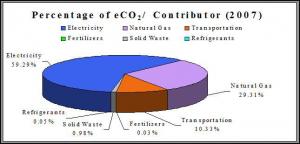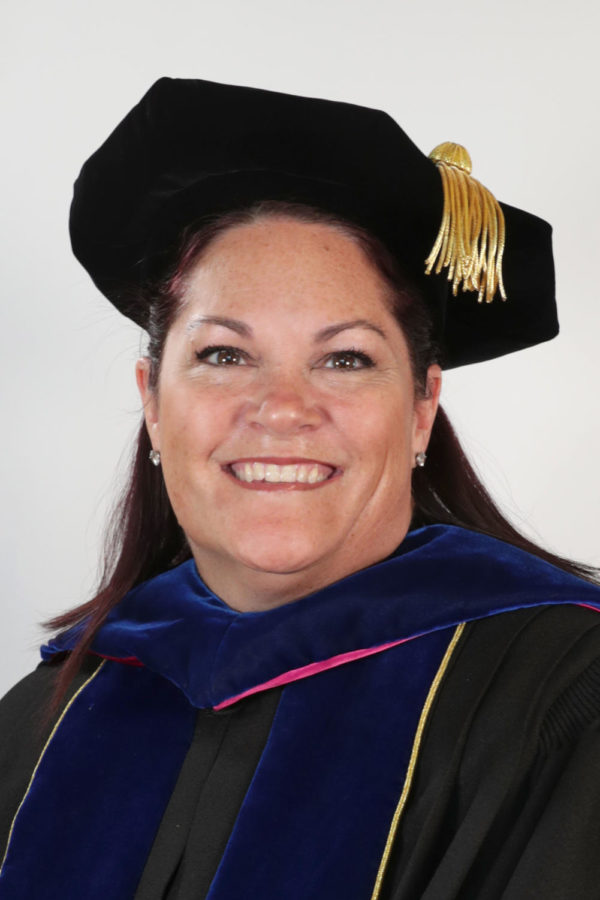 Distribution of Mercyhurst’s greenhouse gas emitions for the 2007-2008 school year, in percentages
Distribution of Mercyhurst’s greenhouse gas emitions for the 2007-2008 school year, in percentages
In fall 2007, Mercyhurst College President Dr. Tom Gamble signed the American College & University Presidents Climate Commitment (ACUPCC) agreement.
This agreement requires that Mercyhurst College establish an institutional structure to oversee the completion of an emissions inventory, develop a climate neutrality action plan, reduce greenhouse gas emissions, integrate sustainability into the college curriculum and make their climate action plan, inventory and progress reports available to the public.
Mercyhurst College is now one of the 1,200 campuses in the United States, participating in the greenhouse gas (GHG) emissions inventory.
Mercyhurst College senior Brittany Prischak conducted an inventory of the college’s emissions from 2001 to 2008 as part of her thesis, “Greenhouse Gas Emissions Inventory of Mercyhurst College Main Campus: Data Collection and Findings for School Years of 2001/2002-2007/2008.”
Data about the college’s campus population, building space, electricity, natural gas, fertilizers, refrigerants, solid waste, commuter, air, and college fleet transportation was gathered and entered into the Campus Carbon Calculator provided by Clean Air-Cool Planet, Inc. (“www.cleanair-coolplanet.org/).
This inventory revealed that the top three contributors to Mercyhurst’s GHG emissions are electricity, natural gas and transportation, as seen in Table 1.
It is intended for a member of the student body to update this inventory each year, but according to biology professor John Campbell, “No one has yet stepped up to the plate.”
With the addition of the new dorm and plans for a new academic building underway, it is foreseeable that Mercyhurst’s energy and natural gas needs will increase. However, this does not mean that the college cannot reduce its emission of GHGs.
The college already uses solar panels to help supplement its energy needs and the Hirt Academic building is exothermally heated. Hopefully, the ACUPCC agreement will encourage the college to pursue further actions to make the campus carbon neutral.
“Now that the school has completed the first step of the ACUPCC agreement, I hope it won’t be long before we see the completion of the other steps,” the Green Team president, senior Zoey Alderman-Tuttle, said. Apparently a plan is already under way.
Last spring, senior Michelle Zaccagnino presented to college administrators a plan of action that included making students aware of how they can help cut down on electricity use, help facilitate commuter carpools, replace single pane glass windows with double pane glass to prevent heat loss and cut down on natural gas consumption, and several other ideas on how to make the campus greener including composting and biodegradable to-go containers.
“I think the campus has made a lot of effort to be more environmentally friendly, but certainly more can and should be done. I think programs that teaching students how to be green in their everyday lives would have a huge impact on the amount of greenhouse gas emissions we produce,” senior Emily McDowell said about suggestions for creating a carbon neutral campus.
“I think awareness is key, not just about what the problem is but how we can fix it. I don’t think anyone would be opposed to something as easy as flipping a switch, especially if it means we help save our plant,” senior Josh Tracy said about the idea of enacting methods to reduce the college’s GHGs.
It is up to the student body, with the aid of faculty and staff, to continue the work started by Prischak and Zaccagnino and help make Mercyhurst College a carbon neutral campus.




